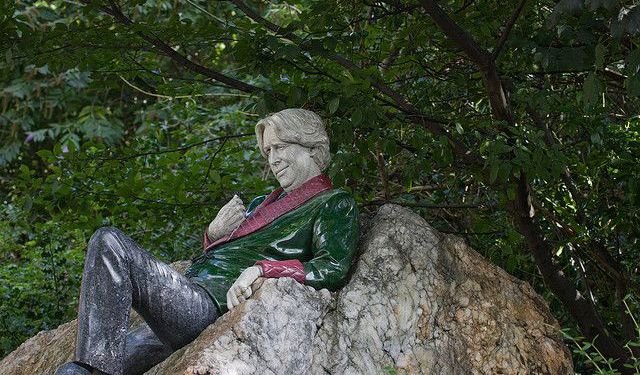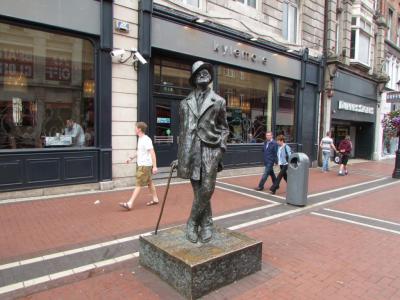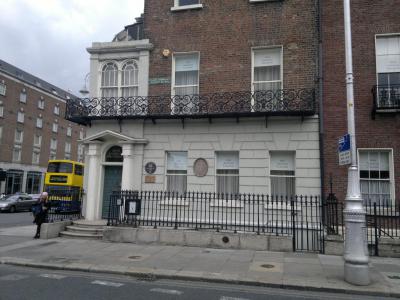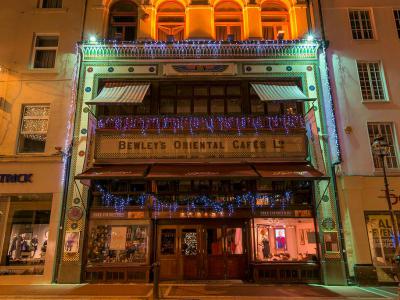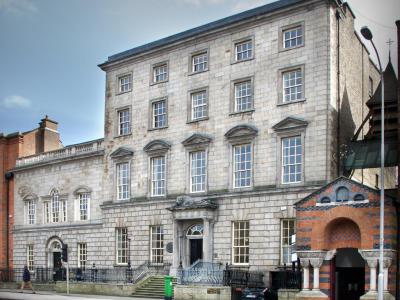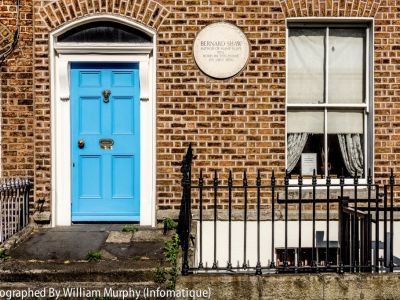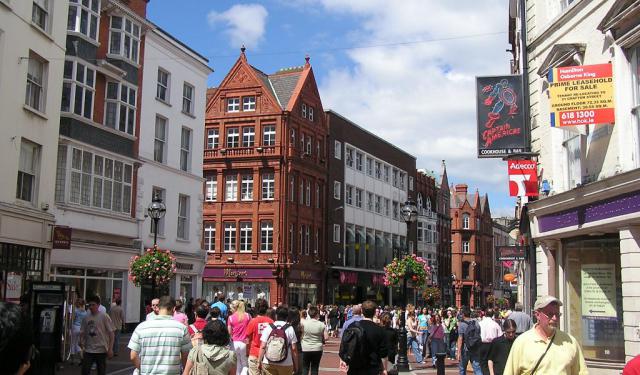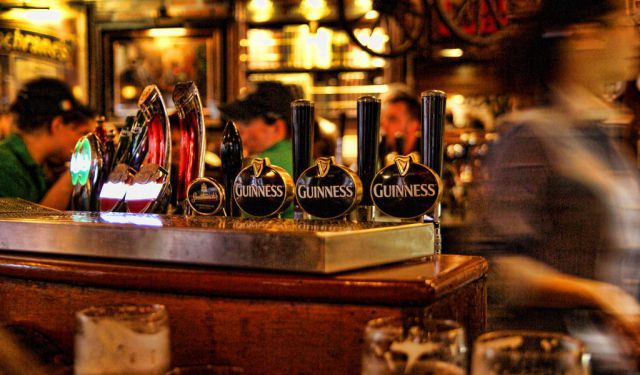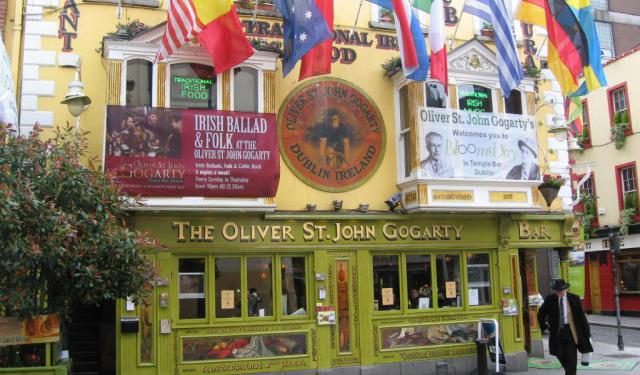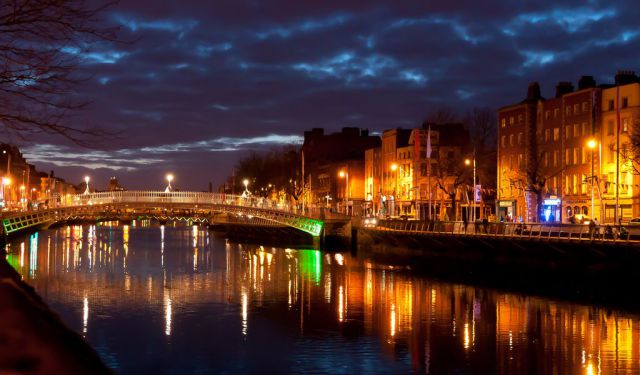A Walk with Famous Irish Writers (Self Guided), Dublin
Albeit a small country, Ireland has given the world a plethora of remarkable writers and poets, many of whom were born, lived, and studied in Dublin. Needless to say, as an epicenter of Ireland's literary scene, Dublin boasts a myriad of hallowed locations closely associated with the luminaries of Irish literature, such as James Joyce, William Butler Yeats, Samuel Beckett, and many of their esteemed peers.
Ardent bibliophiles with a keen interest in the works and lives of Ireland's literary greats can start their quest on North Great George's Street. Here, a resplendent Georgian townhouse accommodates the James Joyce Centre that pays homage to the indomitable genius of one of Ireland's most revered wordsmiths.
Venturing further toward North Earl Street, you will find another, sculpted tribute to Joyce. Perched on a small pedestal, a bronze statue of the writer invites contemplation, capturing his essence in an arresting pose.
The elegant Georgian dwelling at 1 Merrion Square is the childhood home of yet another one of Ireland's most renowned literary maestros, Oscar Wilde. The famous playwright, poet, novelist, and wit extraordinaire spent his formative years at this address.
Amid the bustling thoroughfare of Grafton Street, behold the venerable Bewley's Cafe, a fabled rendezvous steeped in literary lore. Samuel Beckett, James Joyce, and other literary cognoscenti once frequented and found solace at this establishment, leaving an indelible imprint on the very fabric of its storied existence.
Stepping into the regal confines of Newman House, ensconced on the verdant grounds of St Stephen's Green, literary aficionados get transported into the cultural haven of the Museum of Literature Ireland, the nation's literary pantheon.
A pilgrimage to George Bernard Shaw's birthplace on Synge Street garners a rightful mention as an ode to his theatrical brilliance. Marked by a solemn commemorative plaque, this humble abode stands as a testament to the enduring legacy of one of Ireland's most illustrious playwrights and a Nobel laureate.
While Dublin is the fulcrum of Ireland's literary heritage, the abundance of distinguished domains associated with famous authors beckons discerning travelers with a promise of a mesmerizing experience. If you're a curious soul with a passion for words and wanderlust, this captivating self-guided journey through the fabled pages of Dublin's literary legacy will do you good.
Ardent bibliophiles with a keen interest in the works and lives of Ireland's literary greats can start their quest on North Great George's Street. Here, a resplendent Georgian townhouse accommodates the James Joyce Centre that pays homage to the indomitable genius of one of Ireland's most revered wordsmiths.
Venturing further toward North Earl Street, you will find another, sculpted tribute to Joyce. Perched on a small pedestal, a bronze statue of the writer invites contemplation, capturing his essence in an arresting pose.
The elegant Georgian dwelling at 1 Merrion Square is the childhood home of yet another one of Ireland's most renowned literary maestros, Oscar Wilde. The famous playwright, poet, novelist, and wit extraordinaire spent his formative years at this address.
Amid the bustling thoroughfare of Grafton Street, behold the venerable Bewley's Cafe, a fabled rendezvous steeped in literary lore. Samuel Beckett, James Joyce, and other literary cognoscenti once frequented and found solace at this establishment, leaving an indelible imprint on the very fabric of its storied existence.
Stepping into the regal confines of Newman House, ensconced on the verdant grounds of St Stephen's Green, literary aficionados get transported into the cultural haven of the Museum of Literature Ireland, the nation's literary pantheon.
A pilgrimage to George Bernard Shaw's birthplace on Synge Street garners a rightful mention as an ode to his theatrical brilliance. Marked by a solemn commemorative plaque, this humble abode stands as a testament to the enduring legacy of one of Ireland's most illustrious playwrights and a Nobel laureate.
While Dublin is the fulcrum of Ireland's literary heritage, the abundance of distinguished domains associated with famous authors beckons discerning travelers with a promise of a mesmerizing experience. If you're a curious soul with a passion for words and wanderlust, this captivating self-guided journey through the fabled pages of Dublin's literary legacy will do you good.
How it works: Download the app "GPSmyCity: Walks in 1K+ Cities" from Apple App Store or Google Play Store to your mobile phone or tablet. The app turns your mobile device into a personal tour guide and its built-in GPS navigation functions guide you from one tour stop to next. The app works offline, so no data plan is needed when traveling abroad.
A Walk with Famous Irish Writers Map
Guide Name: A Walk with Famous Irish Writers
Guide Location: Ireland » Dublin (See other walking tours in Dublin)
Guide Type: Self-guided Walking Tour (Sightseeing)
# of Attractions: 6
Tour Duration: 2 Hour(s)
Travel Distance: 4.5 Km or 2.8 Miles
Author: max
Sight(s) Featured in This Guide:
Guide Location: Ireland » Dublin (See other walking tours in Dublin)
Guide Type: Self-guided Walking Tour (Sightseeing)
# of Attractions: 6
Tour Duration: 2 Hour(s)
Travel Distance: 4.5 Km or 2.8 Miles
Author: max
Sight(s) Featured in This Guide:
- James Joyce Centre
- James Joyce Statue
- Oscar Wilde House
- Bewley's Cafe Theatre
- Museum of Literature Ireland (MoLI)
- Shaw Birthplace Museum
1) James Joyce Centre
Occupying a grandiose 18th-century Georgian townhouse from a time when Dublin's north inner city fancied itself the belle of the ball, the JJC throws a literary fiesta celebrating Ireland's most imaginative yet intricate wordsmith. Joyce, who once called the inner northside home, spun his tales from the fabric of his surroundings, weaving characters and settings with the finesse of a spider knitting a web.
Decked out with fancy stucco mouldings by Michael Stapleton, the building houses a quaint ground-floor shop brimming with Joyce-related memorabilia, including books and prints. An airy courtyard showcases the authentic period door of 7 Eccles Street, the fictional residence of Leopold and Molly Bloom, central figures in "Ulysses", alongside a puzzling Joyce-inspired sculpture of a cow.
On the upper floors, guests are transported to a recreation of Joyce's modest room in Trieste. Here, an array of books, pianola music-rolls, and a remarkable collection of hats evoke the atmosphere of his creative sanctuary, while touchscreen consoles offer insights into the the evolution of "Ulysses" and its diverse cast of characters. Visitors can delve deeper into the writer's life through three short docu-films.
Decked out with fancy stucco mouldings by Michael Stapleton, the building houses a quaint ground-floor shop brimming with Joyce-related memorabilia, including books and prints. An airy courtyard showcases the authentic period door of 7 Eccles Street, the fictional residence of Leopold and Molly Bloom, central figures in "Ulysses", alongside a puzzling Joyce-inspired sculpture of a cow.
On the upper floors, guests are transported to a recreation of Joyce's modest room in Trieste. Here, an array of books, pianola music-rolls, and a remarkable collection of hats evoke the atmosphere of his creative sanctuary, while touchscreen consoles offer insights into the the evolution of "Ulysses" and its diverse cast of characters. Visitors can delve deeper into the writer's life through three short docu-films.
2) James Joyce Statue
No other scribe has managed to bottle the essence of his hometown quite like James Joyce did with his epic novels, especially the mind-bending "Ulysses". Joyce's detailed descriptions of Dublin's nooks and crannies on that fateful day of June 16th are so spot-on that you can literally follow his characters' footsteps. Every year, Joyceans celebrate this tradition called Bloomsday by retracing the characters' journeys across the city, but you can also explore the route on your own.
"Dubliners" and the mammoth "Ulysses" are both firmly rooted in the Irish capital, making it the perfect stage to honor the author's legacy. And as a nod to the man himself, Dubliners decided to immortalize him in brass in 1990, complete with his signature cane stroll at the intersection of O'Connell Street and North Earl Street. Among the cheeky locals, the statue is known as the 'Prick with the Stick'.
"Dubliners" and the mammoth "Ulysses" are both firmly rooted in the Irish capital, making it the perfect stage to honor the author's legacy. And as a nod to the man himself, Dubliners decided to immortalize him in brass in 1990, complete with his signature cane stroll at the intersection of O'Connell Street and North Earl Street. Among the cheeky locals, the statue is known as the 'Prick with the Stick'.
3) Oscar Wilde House
The Oscar Wilde House at 1 Merrion Square–one of Dublin's last magnificent Georgian squares– holds a rich history. It was here that Oscar Wilde's father, William, a renowned surgeon, settled in 1855 when Oscar was just a year old. The senior Wilde conducted consultations from the house, which has since been restored to showcase several antique surgical instruments on loan from the Royal College of Surgeons. Interestingly, the basement, once William's operating theatre, now serves as a café.
Following William Wilde's passing in 1876, his widow faced significant debts and was forced to sell the house, relocating to England. Despite changing hands, the property remained a family residence for years until it was subdivided into flats and studios. By 1971, it had deteriorated to the point of being boarded up, remaining so for over two decades. However, in 1994, the American College of Dublin undertook a comprehensive renovation, breathing new life into the historic space. Ancient wood floors were revitalized, intricate cornices restored, and antique mirrors hung throughout the halls, dining room, and drawing room.
Today, the top two floors accomodate classrooms for students, while other rooms host art and sculpture exhibitions, lectures by artists, conferences, and private events. Original Wilde family belongings, including Oscar's book collection and the Irish oak floorboards, are still in place. Visitors are encouraged to explore the neo-classical reliefs on the walls and admire the colored windows. Guided tours, particularly on Saturdays, offer a fascinating glimpse into the house's storied past, although self-guided tours are equally recommended.
Tip:
Stroll through Merrion Square Park, sauntering along the secret, leafy trails to discover the immaculately groomed gardens. Keep your eyes peeled for the statue of Oscar Wilde lounging on a boulder in the park's northeast nook, sporting a smoking jacket with red lapels.
Following William Wilde's passing in 1876, his widow faced significant debts and was forced to sell the house, relocating to England. Despite changing hands, the property remained a family residence for years until it was subdivided into flats and studios. By 1971, it had deteriorated to the point of being boarded up, remaining so for over two decades. However, in 1994, the American College of Dublin undertook a comprehensive renovation, breathing new life into the historic space. Ancient wood floors were revitalized, intricate cornices restored, and antique mirrors hung throughout the halls, dining room, and drawing room.
Today, the top two floors accomodate classrooms for students, while other rooms host art and sculpture exhibitions, lectures by artists, conferences, and private events. Original Wilde family belongings, including Oscar's book collection and the Irish oak floorboards, are still in place. Visitors are encouraged to explore the neo-classical reliefs on the walls and admire the colored windows. Guided tours, particularly on Saturdays, offer a fascinating glimpse into the house's storied past, although self-guided tours are equally recommended.
Tip:
Stroll through Merrion Square Park, sauntering along the secret, leafy trails to discover the immaculately groomed gardens. Keep your eyes peeled for the statue of Oscar Wilde lounging on a boulder in the park's northeast nook, sporting a smoking jacket with red lapels.
4) Bewley's Cafe Theatre
Behold this truly iconic café, which first flung open its doors in 1927, sprawling across multiple floors. Snagging a coveted window seat offers prime views of bustling Grafton Street, while the ground floor showcases six exquisite stained-glass windows by Harry Clarke.
Once the stomping grounds of Whyte's Academy, a school that counted the Duke of Wellington and Robert Emmet among its pupils, this establishment has earned its stripes as a "Dublin landmark". Drawing inspiration from the grand cafés of Paris and Vienna, it has long served as a beloved meeting spot for locals and a haven for leisurely reading sessions, attracting literary luminaries like James Joyce, Patrick Kavanagh, Samuel Beckett, and Sean O'Casey over the years.
Today, the menu features a delightful array of pizzas, pastas, and fresh salads, alongside traditional Bewley's breakfasts and decadent cream cakes. During interludes of short plays in the second-floor café theatre, patrons can enjoy a light lunch, while evenings are infused with the lively rhythms of cabaret, jazz, and comedy.
Once the stomping grounds of Whyte's Academy, a school that counted the Duke of Wellington and Robert Emmet among its pupils, this establishment has earned its stripes as a "Dublin landmark". Drawing inspiration from the grand cafés of Paris and Vienna, it has long served as a beloved meeting spot for locals and a haven for leisurely reading sessions, attracting literary luminaries like James Joyce, Patrick Kavanagh, Samuel Beckett, and Sean O'Casey over the years.
Today, the menu features a delightful array of pizzas, pastas, and fresh salads, alongside traditional Bewley's breakfasts and decadent cream cakes. During interludes of short plays in the second-floor café theatre, patrons can enjoy a light lunch, while evenings are infused with the lively rhythms of cabaret, jazz, and comedy.
5) Museum of Literature Ireland (MoLI)
Nestled within the original grounds of University College Dublin, where literary legends like James Joyce and Mary Lavin once found inspiration, this newly minted museum, unveiled in 2019, refuses to be a dusty relic of the past. Instead, it's a celebration of Ireland's rich literary tapestry, blending the old and the new in curious ways. From marveling at the first edition of "Ulysses" to shining a spotlight on overlooked female writers, the museum offers a fresh perspective on Ireland's literary scene beyond Joyce's towering legacy.
Perched overlooking both Saint Stephen's Green and Iveagh Gardens, the museum finds its home in the grand Aula Maxima, a Victorian assembly hall within the historic UCD Newman House complex. Cutting-edge multimedia exhibitions take visitors on a journey through Ireland's literary evolution, from ancient storytelling traditions to contemporary voices. Retirees and visitors alike find solace in the picturesque courtyard, enjoying a leisurely read with a steaming cuppa while tuning in to RadioMoLI for interviews with today's writers.
Tip:
Don't forget to swing by the fantastic MoLI shop, stocked with books, bespoke Irish crafts, art, and jewelry.
Perched overlooking both Saint Stephen's Green and Iveagh Gardens, the museum finds its home in the grand Aula Maxima, a Victorian assembly hall within the historic UCD Newman House complex. Cutting-edge multimedia exhibitions take visitors on a journey through Ireland's literary evolution, from ancient storytelling traditions to contemporary voices. Retirees and visitors alike find solace in the picturesque courtyard, enjoying a leisurely read with a steaming cuppa while tuning in to RadioMoLI for interviews with today's writers.
Tip:
Don't forget to swing by the fantastic MoLI shop, stocked with books, bespoke Irish crafts, art, and jewelry.
6) Shaw Birthplace Museum
Born in 1856 at 33 Synge Street, George Bernard Shaw stands as one of Ireland's most revered literary figures, emblematic of a golden era in Irish writing. While the plaque outside his birthplace modestly labels him as the "author of many plays", Shaw's impact on world literature is far-reaching, earning him a Nobel Prize for Literature during his lifetime.
Despite his later acclaim, Shaw's beginnings were humble, reflected in the unassuming Victorian home where he spent his early years. Restored to evoke the sense that the family has merely stepped out for the afternoon, the simple terraced house offers a glimpse into both Victorian Dublin domesticity and Shaw's formative years. Each room, from the drawing-room hosting his mother's musical gatherings to the children's bedrooms, paints a picture of everyday life, brimming with nostalgia and the ambiance of another era.
It was within these walls that Shaw's imagination first took flight, as he observed the characters and dynamics of his surroundings, later weaving them into the fabric of his literary works. Visiting this charming abode offers not just a glimpse into Shaw's early life, but also a delightful journey back in time to Victorian Dublin.
Despite his later acclaim, Shaw's beginnings were humble, reflected in the unassuming Victorian home where he spent his early years. Restored to evoke the sense that the family has merely stepped out for the afternoon, the simple terraced house offers a glimpse into both Victorian Dublin domesticity and Shaw's formative years. Each room, from the drawing-room hosting his mother's musical gatherings to the children's bedrooms, paints a picture of everyday life, brimming with nostalgia and the ambiance of another era.
It was within these walls that Shaw's imagination first took flight, as he observed the characters and dynamics of his surroundings, later weaving them into the fabric of his literary works. Visiting this charming abode offers not just a glimpse into Shaw's early life, but also a delightful journey back in time to Victorian Dublin.
Walking Tours in Dublin, Ireland
Create Your Own Walk in Dublin
Creating your own self-guided walk in Dublin is easy and fun. Choose the city attractions that you want to see and a walk route map will be created just for you. You can even set your hotel as the start point of the walk.
Dublin Introduction Walking Tour
The Irish capital, Dublin, is a city where history has a pint in one hand and a smartphone in the other. Sitting snugly on Ireland’s east coast, straddling the River Liffey like it owns the place, Dublin is a heady mix of medieval charm, Georgian swagger, and modern-day buzz. The name itself, Dubh Linn (the Celtic expression for “black pool”) sounds mysterious enough - and yes, it refers to... view more
Tour Duration: 2 Hour(s)
Travel Distance: 3.8 Km or 2.4 Miles
Tour Duration: 2 Hour(s)
Travel Distance: 3.8 Km or 2.4 Miles
Pub Crawl
The Irish in general and Dubliners in particular are known for their passion for whiskey and beer. As you embark upon a beguiling odyssey through the spirited streets of the Irish capital, you can't help noticing the reverberating vibrancy coming from its enchanting pubs. A tapestry of libation-laden lore awaits those who traverse the path of the Dublin pub crawl, guided by the siren call of... view more
Tour Duration: 2 Hour(s)
Travel Distance: 2.4 Km or 1.5 Miles
Tour Duration: 2 Hour(s)
Travel Distance: 2.4 Km or 1.5 Miles
Dublin Literary Pubs
The three Ps of Dublin – the pub, the poet, and the pint – have always distinguished the Irish capital as home to some of the most literary pubs in Europe. Indeed, Dublin's public houses, where writers traditionally sharpened their wit, today encapsulate the enchantment of the written word and play a significant role in preserving and celebrating this legacy.
Among these revered... view more
Tour Duration: 1 Hour(s)
Travel Distance: 2.2 Km or 1.4 Miles
Among these revered... view more
Tour Duration: 1 Hour(s)
Travel Distance: 2.2 Km or 1.4 Miles
A Walk Along Liffey River
The River Liffey - Dublin’s liquid backbone - slices through the Irish capital like a great shimmering bookmark, separating the Northside from the Southside in a civil yet longstanding sibling rivalry. Stretching around 125 kilometers, this body of water is indeed a living archive, a story that never quite ends. Stroll along its banks, and you’ll find yourself time-traveling without the hassle... view more
Tour Duration: 1 Hour(s)
Travel Distance: 2.1 Km or 1.3 Miles
Tour Duration: 1 Hour(s)
Travel Distance: 2.1 Km or 1.3 Miles
Useful Travel Guides for Planning Your Trip
16 Distinctively Irish Things to Buy in Dublin
The birthplace of many artistic talents, such as Jonathan Swift and Oscar Wilde, Dublin is the show-window of Ireland, a small country renowned for its rich cultural scene encompassing music, writing, poetry, dance, craftsmanship and more. The food & drink scene of Dublin (much as the whole of...
The Most Popular Cities
/ view all
